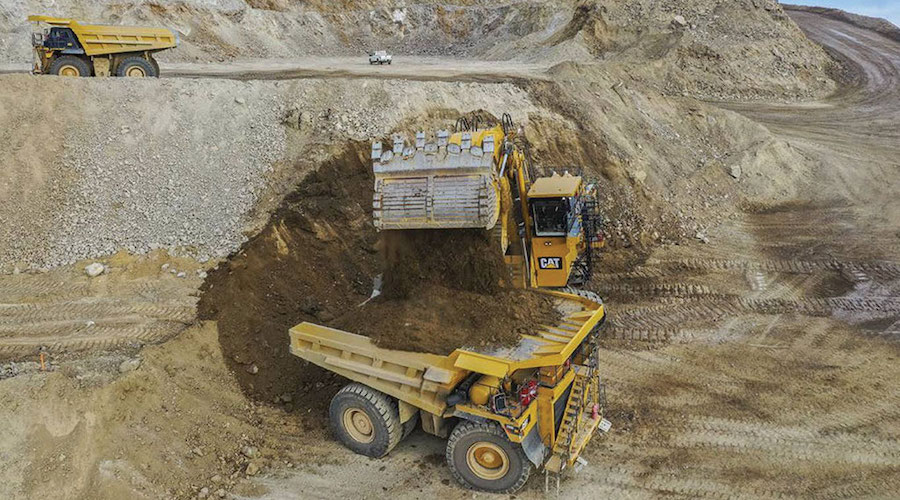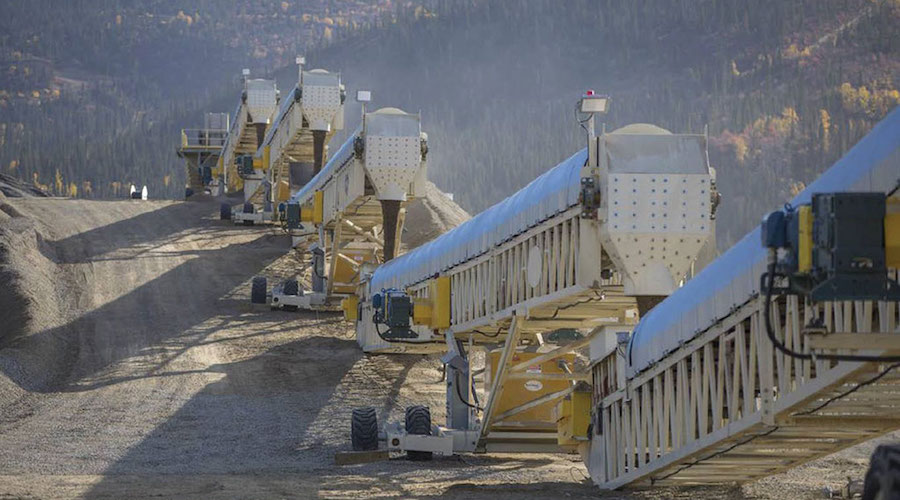
These are exciting days for Victoria Gold (TSXV: VIT), as the company transitions its flagship Eagle open-pit gold project in the Yukon from development into production.
At the end of September, the company had mined 1.7 million tonnes of ore and stacked 1.1 million tonnes of crushed mineralized material on the heap-leach pad, pouring its first gold on Sept. 17.
“After 10 years of blood, sweat and tears, it feels pretty good,” John McConnell, Victoria Gold’s president and CEO, said in an interview with The Northern Miner, adding that he is “guiding people for the second quarter of 2020” in terms of commercial production.
Based on initial mining, gold grade to the leach pad and initial grade reconciliation are in line with expectations, and the company shipped its first 2,450 oz. of 83.3% gold and 8.7% silver doré, valued at over $4 million, to the Royal Canadian Mint on Oct. 8. Victoria expects to continue with weekly pouring and shipment of doré bars.
Eagle is an open-pit, heap-leach operation 350 km north of Whitehorse in the Yukon. The project is located within the 350 sq. km Dublin Gulch property, which Victoria acquired in 2009.
The past few years saw a lot of activity on-site, as the company permitted and constructed Yukon’s newest mine. The company completed a feasibility study on the project in September 2016 and started construction in August 2017. Construction concluded in July for a total of $487 million.
Current

Based on the 2016 feasibility study, Eagle could produce 200,000 oz. gold per year for 10 years based on current reserves. Operating costs are expected at $10.54 per tonne of ore leached, or US$700.50 per oz. all-in sustaining costs (AISCs), including a 5% royalty to Osisko Gold Royalties (TSX: OR; NYSE: OR). Life-of-mine, heap-leach gold recoveries are an expected 70.8%. In a corporate presentation last month, the company forecast average AISCs of less than US$750 per ounce.
McConnell says more detailed guidance on 2020 production forecasts is expected soon.
Funding a project of such scale in the midst of a prolonged downturn in the mining space made Victoria consider various potential financing options. “We were pursuing two or three alternatives, but at the end of the day felt that we came up with reasonable terms with a syndicate of Orion, Osisko and Caterpillar,” McConnell says.
“We made the decision to start construction, as we felt it was the right time to build a mine. Not a lot of mine construction was happening in North America, so we got the A-team and managed to come in under budget and on schedule.”
Details of Eagle’s $505-million financing package were announced in March 2018. It included $125 million in equity, US$225 million in debt (two credit facilities for a total of US$175 million, and a US$50-million equipment finance facility), and a $98-million royalty financing (at a 5% net smelter return royalty, until delivering an aggregate 97,500 oz. to Osisko, and decreasing to 3% thereafter).
As one of the financing conditions, Victoria implemented a gold price-protection (hedging) program with Macquarie Bank. Current gold hedges include 100,000 oz. of put options with a $1,500 per oz. strike price, and 100,000 oz. of call options with a $1,936 per oz. strike price. These include 40,000 oz. in 2020 and 60,000 oz. in 2021. This allows Victoria to sell into the market at prices between the two rates.
In addition, as part of the 2018 financing package, Victoria issued Orion 20,000 oz. of gold call options with an exercise price of US$1,485 per oz. until April 13, 2023. As of Aug. 31, the company had $45.6 million in cash.
In terms of its shareholders, Victoria has, for the most part, attracted a specialized, sector-specific ownership base. Orion Mine Finance — a firm specializing in metals and mining investment — holds a 45% stake in the company, with another 16.2% held by various institutional investors. Kinross Gold (TSX: K; NYSE: KGC), which owns and operates the Fort Knox open-pit, heap-leach mine in Alaska, holds a 6.5% interest in the company.
The mining scenario is only part of the story for Victoria Gold. There are a number of prospective exploration targets within the Dublin Gluch property, with potential to add value in the years to come, McConnell says. “The last three years, we have started to step-out Eagle and look at the regional potential,” McConnell says. “We have 11 or 12 high-priority targets on the Dublin Gulch property of over 500 square kilometres. We believe we have a district-scale play, and we think that the best opportunity to grow Victoria is to do it organically with the properties we have … We hope to build a second mine if there’s a large enough resource.” The Eagle and Olive deposits lie within the 13 km Potato Hills trend, which traverses the 26 km wide property and is part of the wider Tintina gold belt, a prolific structure spanning across Alaska and the Yukon, and host to projects that include the Fort Knox and Pogo mines, as well as the past-producing Brewery Creek deposit.
In September, the company reported results from the 2019 diamond drilling program from the Raven target. Raven is located within the Nugget zone, which, after the Eagle host unit, is the second-largest intrusive body at Dublin Gulch, and is geologically similar to the Eagle deposit. Highlight intercepts include 88 metres of

The Olive-Shamrock-Spinach targets are defined by a soil anomaly with a history of small-scale mining. The current proven and probable reserves at Olive total 200,000 oz. at 0.95 gram gold. Diamond drilling completed on the Shamrock zone in 2017 returned intercepts that included 40 metres of 1 gram gold, including a higher-grade section of 24 metres of 1.36 grams gold, 17 metres of 2.24 grams gold and 23 metres of 2.78 grams gold. All of these intercepts came from the first 100 metres of core.
Diamond drilling at Spinach in 2017 returned 32 metres of 0.78 gram gold, 14 metres of 1.04 grams gold and 137 metres of 0.4 gram gold, including a higher-grade section of 71 metres of 0.58 gram gold from within the first 148 metres downhole.
Diamond drilling completed in 2017 on the Catto zone — a site of historic, high-grade gold production — has returned intercepts that include 24 metres of 1.64 grams gold, 7 metres of 1.19 grams gold and 21 metres of 0.99 gram gold, all in the first 155 metres of core.
For now, McConnell’s attentions are focused on bringing production up to capacity.
As the first gold pour was announced, McConnell commented, “Looking back, this is the culmination of many years of dedication and hard work by numerous stakeholders. Looking forward, this first gold pour is expected to be swiftly followed by positive cash flow, and we intend to grow production and resulting cash flow into the future.”
(This article first appeared in the November 11-24, 2019 edition of The Northern Miner).